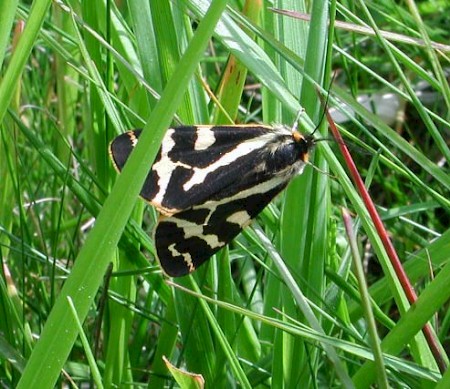Ecaille du plantain : Différence entre versions
(Nouvelle page : Category:Insectes <br> ====== Etymologie ====== --- <br> ====== Description ====== --- <br> ====== Répartition ====== --- <br> ====== Habitat ====== --- <br> ...) |
m (A déprotégé « Ecaille du plantain ») |
||
| (4 révisions intermédiaires par le même utilisateur non affichées) | |||
| Ligne 1 : | Ligne 1 : | ||
[[Category:Insectes]] | [[Category:Insectes]] | ||
| − | <br> | + | [[Image:Ecaille du plantain Parasemia plantaginis.jpg|Image:Ecaille_du_plantain_Parasemia_plantaginis.jpg]]<br> Ecaille du plantain ''Parasemia plantaginis'' - photo © Graham Catley |
====== Etymologie ====== | ====== Etymologie ====== | ||
| − | + | *'''Nom latin''' : ''Parasemia plantaginis'' | |
| − | + | *'''Nom anglais''' : Wood Tiger | |
| − | + | *'''Famille''': '''Arctiidae'''. | |
====== Description ====== | ====== Description ====== | ||
| − | + | *'''Taille''' : 32-38 mm | |
| − | + | *Ailes postérieures du mâle, noires plus du blanc ou du jaune alors que chez la femelle, elles sont rouges plus du brun. | |
| − | + | ====== Plantes hôtes ====== | |
| + | *'''Chenille polyphage''', se nourrissant sur diverses plantes herbacées dont : plantains ''Plantago'' sp., Piloselle ''Hieracium'' sp., séneçon commun ''Senecio'' sp., pissenlit, silènes et d'autres plantes basses. | ||
====== Répartition ====== | ====== Répartition ====== | ||
| − | + | *'''Paléarctique'''. | |
| − | + | *'''France''' : partout sauf ouest et sud. | |
| − | |||
====== Habitat ====== | ====== Habitat ====== | ||
| − | + | *Bois clair, friches, prairies humides acides. | |
| − | + | ====== Ecologie ====== | |
| − | + | *Le mâle vol de jour alors que la femelle est nettement nocturne. | |
| − | |||
| − | |||
| − | |||
| − | |||
| − | ====== | ||
| − | |||
| − | |||
| − | |||
====== Statut ====== | ====== Statut ====== | ||
| − | + | *Pas de statut de protection connu. | |
| − | + | ====== Bibliographie ====== | |
| − | + | *Bebbington John & Lewington Richard (2007) - '''Guide to the hawkmoths of the British Isles'''. Edition Field Studies Council (FSC). | |
| − | ====== | + | *Leraut Patrice (2006) - '''Papillons de nuit d'Europe, bombyx, sphinx, écailles...''' VOL I. NAP éditions. |
| − | + | *Leraut Patrice (2009) - '''Papillons de nuit d'Europe, géomètres''' VOL II. NAP éditions. | |
| − | --- | + | *Lewington Richard (2006) - '''Guide to the day-flying moths of Britain'''. Edition Field Studies Council (FSC) |
| + | *Manley Chris (2008) - '''British moths and butterflies, a photographic guide'''. Edition A & C Black. | ||
| + | *Robineau Roland (2007) -'''Guide des papillons nocturnes de France''', plus de 1620 espèces décrites et illustrées. Edition Delachaux & Niestlé. | ||
| + | *Skinner Bernard (2009) -'''Colour identification guide to moths of the British isles'''. Edition Apollo Books. | ||
| + | *Townsend M. & Waring P. (2007) -'''Concise guide to the moths of great Britain and Ireland'''. Edition British Wildlife Publishing | ||
| + | *Waring Paul & Townsend Martin (2009)- '''Field guide to the moths of great Britain and Ireland'''. Edition British Wildlife Publishing. | ||
| + | *Young Mark (1997) -'''Natural History of Moths'''. Edition T & AD Poyser Ltd (A & C Black). | ||
Version actuelle datée du 30 septembre 2015 à 08:14

Ecaille du plantain Parasemia plantaginis - photo © Graham Catley
Sommaire
[masquer]Etymologie[modifier]
- Nom latin : Parasemia plantaginis
- Nom anglais : Wood Tiger
- Famille: Arctiidae.
Description[modifier]
- Taille : 32-38 mm
- Ailes postérieures du mâle, noires plus du blanc ou du jaune alors que chez la femelle, elles sont rouges plus du brun.
Plantes hôtes[modifier]
- Chenille polyphage, se nourrissant sur diverses plantes herbacées dont : plantains Plantago sp., Piloselle Hieracium sp., séneçon commun Senecio sp., pissenlit, silènes et d'autres plantes basses.
Répartition[modifier]
- Paléarctique.
- France : partout sauf ouest et sud.
Habitat[modifier]
- Bois clair, friches, prairies humides acides.
Ecologie[modifier]
- Le mâle vol de jour alors que la femelle est nettement nocturne.
Statut[modifier]
- Pas de statut de protection connu.
Bibliographie[modifier]
- Bebbington John & Lewington Richard (2007) - Guide to the hawkmoths of the British Isles. Edition Field Studies Council (FSC).
- Leraut Patrice (2006) - Papillons de nuit d'Europe, bombyx, sphinx, écailles... VOL I. NAP éditions.
- Leraut Patrice (2009) - Papillons de nuit d'Europe, géomètres VOL II. NAP éditions.
- Lewington Richard (2006) - Guide to the day-flying moths of Britain. Edition Field Studies Council (FSC)
- Manley Chris (2008) - British moths and butterflies, a photographic guide. Edition A & C Black.
- Robineau Roland (2007) -Guide des papillons nocturnes de France, plus de 1620 espèces décrites et illustrées. Edition Delachaux & Niestlé.
- Skinner Bernard (2009) -Colour identification guide to moths of the British isles. Edition Apollo Books.
- Townsend M. & Waring P. (2007) -Concise guide to the moths of great Britain and Ireland. Edition British Wildlife Publishing
- Waring Paul & Townsend Martin (2009)- Field guide to the moths of great Britain and Ireland. Edition British Wildlife Publishing.
- Young Mark (1997) -Natural History of Moths. Edition T & AD Poyser Ltd (A & C Black).